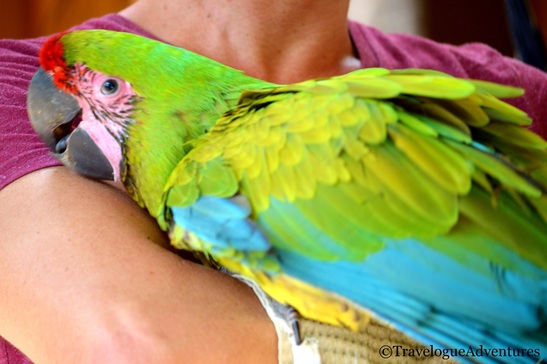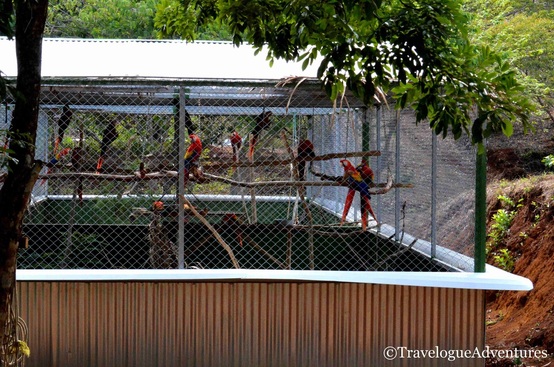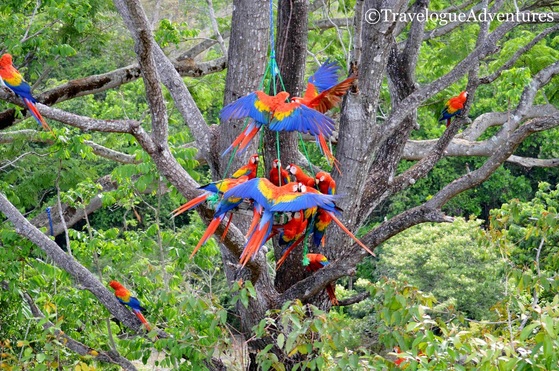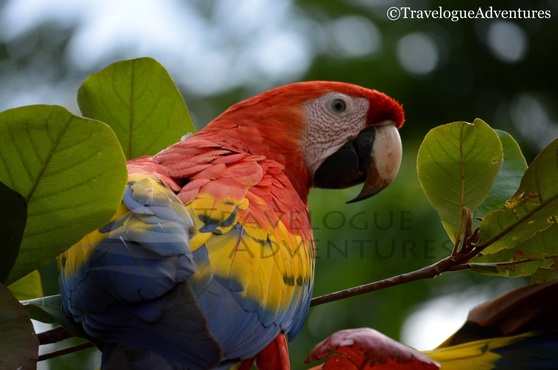Last Updated: July 15, 2025
Even before we moved to Costa Rica in 2013, we had been closely following an organization called the Ara Project and their efforts to breed and release endangered Scarlet and Great Green Macaw parrots into the wild. Some of you might remember that we did a fundraiser called Help Save the Macaws when our book was first published in 2012. That campaign was to help build a new facility on the southern Nicoya Peninsula. This post shares our experience visiting the Ara Project’s amazing Punta Islita breeding and release center several years ago.
Note: We visited the project when it was the Ara Project. Now the organization is run by the Macaw Recovery Network, another wonderful conservation group. There is still a sister project called Ara Manzanillo on Costa Rica’s Caribbean coast, which is also worth a visit.
Getting to Punta Islita
We arrived in the small town of Punta Islita after a bumpy hour and a half long ride from Nosara. It was our first drive that far down the Nicoya Peninsula and we weren’t entirely sure we were going to make it. There was a river crossing, but luckily the water was low since it was still early in the rainy season.
After crossing the Rio Oro and traversing up and down some steep, jungle-lined hills, we finally arrived. We scoped out the town and visited Museo Islita, a small open air contemporary art museum, then sat down for lunch at Hotel Punta Islita, a resort right on the beach, and one of the only places around. Afterwards, it was time to meet the birds.
Meeting the Macaws
We headed up the hill and through a large gate to the Macaw breeding center. Our host, Juan Carlos, an avian specialist and the Project’s site manager, greeted us warmly. He got the tour started right away, not wasting any time introducing us to the almost 100 parrots.
Dozens of Scarlet Macaws were flying in the surrounding trees and others squawked from large enclosures, which serve as a nursery and school for these colorful birds.
While holding Precious, a resident Great Green Macaw, on his arm, Juan Carlos taught us about these magnificent birds.
Macaw Facts
Here are some of the many fascinating things we learned about Scarlet and Great Green Macaws.
- Macaws live for 70-80 years.
- They form bonding pairs when they are young and stay paired for life.
- Nests are made in hollow trees and often the Macaws will widen old woodpecker holes to build them.
- 2-3 eggs are laid but only one chick, the strongest, is kept and nurtured by the parents.
- Macaws play an important ecological role in seed dispersal in the jungle.
- The range of Macaws in Costa Rica has been drastically diminished by development/deforestation, agriculture, and the illegal pet trade.
- Fewer than 1,000 Great Green Macaws are thought to still live in the wild. The range of Great Green Macaws is severely restricted because their primary food source, the mountain almond, is almost non-existent. For this reason, they release Great Greens in Manzanillo near Puerto Viejo on the Caribbean coast. This is one of the only places in Costa Rica where mountain almond trees remain.

Learning About the Work of the Macaw Recovery Network
Now that we knew a little about the birds, Juan Carlos led us higher up the hill to the education center. Here he explained what the breeding center was all about.
Most people think that the Project rehabilitates Macaws and releases them back into the wild, but that is not the case. Instead, a number of resident pairs are specifically bred in captivity.
Since the parents will care for only one of the hatchlings, the Punta Islita team cares for the remaining chicks. This is more than a full-time job for the small staff, as the hungry chicks demand food around the clock, hourly at first, and then every few hours.
Eventually, though, the young chicks grow and are taught by the staff which foods to eat on their own. When they are more independent, they are released, eating in the wild around Punta Islita (for Scarlet Macaws) and eastern Costa Rica (for Great Greens).
To help the birds adapt, food is supplemented at designated feeders. The other chicks, raised by the breeding pairs, stay in captivity to become the future breeding pairs.

While inside the education center, we also learned what the birds eat and saw samples of the different seeds like Wild Almond, Guanacaste, Naked Indian, and African Palm. We learned that food supplies are limited in the wild due to deforestation and development, and that the staff goes out daily to collect enough food to meet the demand of the ravenous birds.
Feeding Time
After our lesson, Juan Carlos opened the back door and led us outside. His timing was strategic as the staff was about to fill the supplemental feeders.
All around us, Scarlet Macaws flew between trees, loudly announcing to one another that the feast was about to begin. They had flown back to the center from the surrounding forest, eager for the daily gathering.

For us, seeing these magnificent parrots in flight instead of behind the bars of a cage was truly a magical experience.
As of the time of our visit, the Ara Project had released around 80 Scarlet Macaws and 32 Great Green Macaws back into the jungles of Costa Rica and there were dozens more waiting in the wings (pun intended).
Impressively, there was an 85-90% success rate on releases, and at the Project’s first release site, Scarlet Macaws were even breeding in the wild. To help keep those birds safe, the organization reached out to area schools to educate local children in the hopes that they would grow to respect and protect future populations.
We couldn’t have been more impressed with the work done by the dedicated staff at the Ara Project/Macaw Recovery Network.
How to Visit
If you’d like to visit the Punta Islita release site, tours are available with reservations at 7:30 a.m. or 4:00 p.m.
The 1-hour tour is $24.86/adult, $12.43/child under 16. Reservations can be made through the Macaw Recovery Network’s website.
Volunteer opportunities are also available for those wanting to lend a hand. Visit the Volunteer Page for more information.
Tours with transportation are also available through tour operators in Samara.
Live Cam
Can’t get to Punta Islita for a tour? The Macaw Recovery Network has some live cams where you can see what the Macaws are up to.
Have a question about visiting the Macaw Recovery Network? Ask us below.
Looking for more information to help you explore this part of Costa Rica? Check out these posts:
Samara: Guanacaste’s Most Overlooked Beach Town – This is the closest major beach town to Punta Islita and the Macaw Recovery Network.
Dolphin Watching and Snorkeling in Samara – This fun tour will get you out on the water in search of dolphins, whales, sea turtles, and lots of fish.
Things to Do in Samara – Learn about more fun things to do in the area, including two hiking options and the local farmers market.
Wildlife Tours & More Things to Do – Costa Rica has several wildlife rehabilitation centers where you can learn about the work being done to help birds and animals in Costa Rica. Learn more on our Wildlife page. Or browse other activities all around the country on our Things to Do page.




